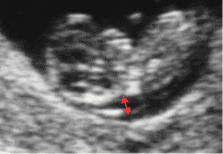|

|
|
|
11.4 Clinical and prenatal examinations
|
|
|
|
With today's technical possibilities various chromosomal aberrations can already be determined before birth.
|
|
|
|
In order to reduce the risk of the birth of a severely handicapped child, by means of amniocentesis or a chorionic villus biopsy during early pregnancy, the future mother can have the chromosome set of the embryo examined for chromosomal aberrations.
|
|
|
| Fig. 22 - Various access paths for prenatal diagnostic examinations |
|
Legend |

1
2
3
4
5
A
B
C
D
|
Embryo
Amniotic cavity
Chorionic cavity
Uterine cavity
Chorion frondosum
Amniocentesis through the abdominal wall
Chorionic villus biopsy through the abdominal wall
Umbilical cord puncture (umbilical vein)
Transvaginal chorionic villus biopsy |
|
|
|
Fig. 22
In early pregnancy, the collection of embryonic tissue or fluids (chorionic villus biopsy or amniocentesis) is performed mostly transvaginally. Depending on how the uterus is positioned, though, one can also proceed transabdominally.
|
|
Sometimes, chromosomal aberrations can also be suspected in the 1st ultrasound examination based on a neck edema.
|
|
|
| Fig. 23 - Normal ultrasound image |
|
Fig. 24 - Neck edema of a fetus
(12th week of pregnancy) |
|
Legend |

|
|

|
|
Fig. 23,24
A neck edema (red arrow) corresponds to a collection of fluid that is present temporarily between the 11th and 14th week of pregnancy and can indicate a chromosomal aberration.
|
|
If there is evidence of an increased incidence of congenital abnormalities, monogenetic hereditary diseases or habitual abortions in the anamnesis, genetic counseling should by all means be offered.
|
|
|
|
More info
|
|
The most recent examinations of ultrasound images made between the 11th and 14th weeks of gestation have shown that the nasal bone is visible in profile in 99.5% of the fetuses without chromosomal aberrations, whereas it is missing in 73% of the fetuses with trisomy 21. (12)
|
|
|
|
|
|
Children with a deviating number or structure of chromosomes mostly have multiple abnormalities, often associated with mental retardation, or are in general unable to live. In the clinic a chromosome analysis is indicated when the following criteria are present in a patient and other pathogenic causes have been eliminated::
- Pre- and postnatal growth disorders
- Mental retardation
- Abnormalities
- Dysmorphism signs
|
|
|
More info
|
|
The dysmorphism signs listed in the table certainly occur individually in the general population and thus can only be taken as signs of possible chromosomal aberrations when several are present and in combination with developmental retardation.
|
|
|
|
More info
|
|
Examples of such diseases are:
- Down syndrome or trisomy 21 (an additional chromosome 21). These children are mentally retarded, have typical somatic symptoms and frequently a cardiac defect.
- Trisomy 13 or 18. These children have multiple abnormalities that are mostly lethal.
|
|
|
|
|
|
|

